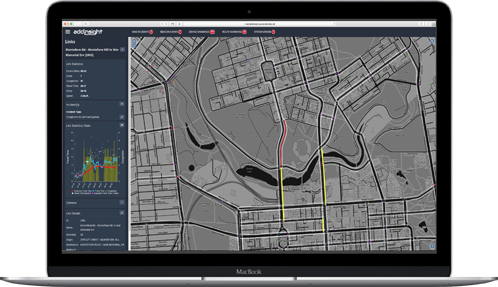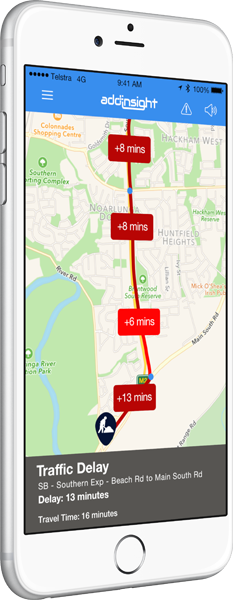
Future Proofing Our Roads
The Government of South Australia’s AddInsight Traffic Intelligence System delivers real-time accurate traffic movements transmitted to a traffic monitoring system to enhance visibility and future-proof road networks.
AddInsight will provide road authorities with an unprecedented insight into the performance of their road network without significant expenditure on hardware. Traffic management centre (TMC), operational and planning staff will all benefit from the system and its outputs. Instead of being stored in isolation on a cloud, the system resides on the road authority’s own network and can be easily adapted to interface with other data sets or systems.

The AddInsight Traffic Intelligence System consists of:
Tough and Intelligent Hardware
Our BRAUMS Intelligent Outstation (BIO) hardware have been time proven in some of the harshest climates and weather conditions the world can throw at ITS equipment. In a low-power plug ’n’ play package, the BIO is ideal for delivering data to the back-end system with minimal installation and maintenance effort.
Customer Support
BRAUMS believes in standing behind our products, supporting our clients after the AddInsight installation and commissioning is successfully complete. We achieve this through multiple levels:
- Training operational personnel
- Training maintenance personnel
- Maintenance & operating manuals
- As built drawings
- Level 1 Helpdesk
- Level 2 BRAUMS support
- Level 3 access to OEM engineering & design expertise
- Recommended customer spares list and supply
- Duplicate spares held in BRAUMS store
BRAUMS and ATC are certified hardware suppliers for AddInsight.

Key Features
- Bluetooth MAC capture, processing and analysis
Background software processes and aggregates all of the data before uploading it all into a system database. Provided field hardware can transmit our message format, any capture device can be used. - Arterial and freeway incident detection / congestion management
Travel times on predefined road sections are calculated every 30 seconds and compared against historic travel time profiles to identify abnormalities. The system uses unique congestion indicators to prioritise suspected incidents. TMC staff can constantly monitor this information via a map or table interface. - Addinsight Smartphone App – Virtual VMS System
The virtual VMS system automatically activates Bluetooth beacons on the approach to a potential incident and transmits real-time delay information. Motorists with the app installed will receive an audio alert detailing the location and type of incident plus the expected additional delays. Once the congestion clears, the system automatically stops broadcasting. - Route travel time predictions
Using a combination of live and historic information, route travel times can be forecast to provide constant comparisons between alternative routes. - Interface with STREAMS ITS Platform
Via the new STREAMS interface, route travel time data can be displayed on VMS signs to suggest alternative routes or can be used to trigger other STREAMS stimuli. Existing STREAMS users will automatically have access to this functionality. - Origin-Destination (O-D) and Select Link Analysis (SLA)
The processed Bluetooth records can be analysed using numerous criteria to extract aggregated O-D matrices for any combination of Bluetooth sites. SLA allows practitioners to observe the routes used by vehicles before and after they pass through selected sites. It can be used to better understand why vehicles use particular roads or turns and can help TMC operators to decide the most appropriate detour routes if an incident occurs. - SCATS VS (flow) and History (phasing) data analysis
The system loads this information from SCATS into the database to allow trends and other impacts to be analysed and compared alongside the Bluetooth data. - Network and subarea statistics
Using the map interface within the software it is possible to extract statistics about the entire network or for just a subarea. The three main outputs are total vehicle-kilometres travelled, total travel time (veh-hrs) and total delay (veh-hrs). These use a combination of the Bluetooth travel time data and SCATS VS data to derive the statistics which can be used for standard network performance reporting or even to measure the delay cost of a specific incident.